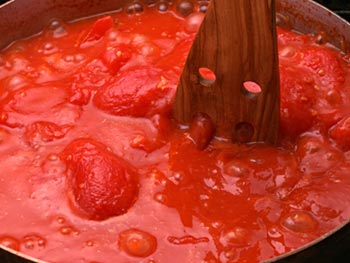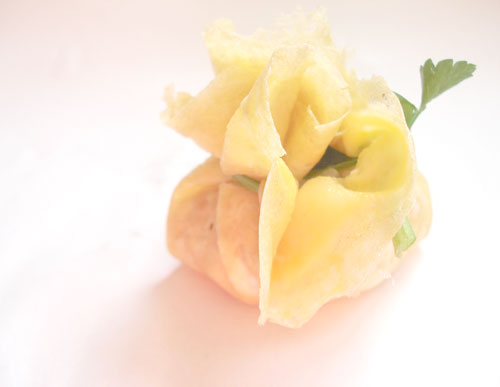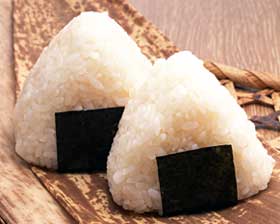I have to admit, that a lot of the baking I do is quite time consuming - such as the desem bread. For me, baking bread is sort of a hobby, not something I just do for the sake of making bread, but it's not practical to bake things that require long kneading and hours of rising time frequently. But not all bread doughs like that. This dough, which can be used for pizza, foccaciaa, calzone, and the like, is very simple to make, especially if you have a food processor.
Filed under:
basics bread baking favorites

I've been posting some of the basic building blocks of Japanese cooking, and I thought I would add some other basics too. While I like to experiment with a new recipes sometimes, for everyday cooking this isn't too practical. So I rely on a few basic recipes that I have more or less memorized, and vary them to produce different results.
Filed under:
basics sauce favorites
The term "teriyaki" is used a lot these days. Usually it indicates that a sweet-savory soy-sauce based sauce called teriyaki sauce has been used. However, teriyaki is actually the word for a cooking method - and it's very easy to do.
Filed under:
basics japanese chicken
So far I have been writing about Japanese foods that are quite traditional. The flavors are based on the SaShiSuSeSo of sugar, salt, rice vinegar, soy sauce and miso, plus the all-important dashi soup stock. In Japan, this kind of food is called washoku, or quite literally "Japanese food".
Filed under:
basics japanese yohshoku

Top row: Sa (satoh=sugar), Shi (shio=salt); Middle row: Su (su=vinegar), Se (shoyu=soy sauce);
Bottom row: So (miso=fermented soy bean paste)
Besides dashi stock, the basic flavors of traditional Japanese cuisine are sugar, salt, soy vinegar, soy sauce and miso. While not many sauces uses all of these ingredients, many use at least 3.
Filed under:
basics japanese ingredients
(This is a revised and expanded version of a recipe that I posted when Just Hungry was brand new.)
Japanese people love eating eggs in many ways. One of the most popular uses for the egg is to make a very thin omelette called usuyaki tamago (literally, thinly cooked egg). Usuyaki tamago is used julienned as a garnish, or as a wrapper for sushi rice and other things.

Filed under:
basics eggs japanese

[Update:] Be sure to check out my easier, neater way to make onigiri!
Onigiri are rice balls, usually with a tasty filling. They are very portable, and therefore are very popular for carry-along lunches. Part of their appeal lies in the fact that if you're Japanese, you just love the taste of rice. It's genetic. [Edit: another word for onigiri is omusubi. I guess it just depends on what word you grew up with. In our house it was always onigiri.]
Onigiri can stand on their own, or be part of a bento or boxed lunch. (For some reason it's never just called "nigiri", though bento is also called obento, which is the honorific term.) Onigiri are also a great make-ahead snack for a crowd, since with the appropriate fillings they keep rather well. I remember my aunt making 12-cups of rice worth of onigiri at a time for the large family gatherings at New Year's or Obon (August festival to pay respect to our ancestors). Her hands would be bright red from the heat of the rice. She favored salted salmon (shio zake) as the filling usually - very salty salmon in fact.
Onigiri is also one of my top comfort foods. It reminds me of the ones my mother used to make for me for school outings (ensoku) as well as countless school lunches. When we stayed at my grandmother's and my cousines and I would take trips to the Chichibu mountain area, my aunt would make huge rice balls to assuage our appetites. There's a comforting feeling of continuity with history too, because Japanese travelers have sustained themselves on those salty rice balls for hundreds of years.
Like obento boxed lunches, onigiri can be elaborate creations, but the simple versions the are best in my opinion. We often bring some onigiri with us on long train trips: it's a lot better than buying the overpriced sandwich buns from the vending carts. Yes, sometimes people look at us curiously as we bite into those soccer-ball colored balls. We don't care one bit.
While I was working on writing up this entry, I came across this post by Mimi Ito . Japanese people have a lot of emotional attachment to obento, and to onigiri too.
Filed under:
basics japanese rice onigiri omusubi
One of the regular features I'll be putting here are some basics of Japanese cooking...since that's what I am (Japanese). Believe me, it's not as hard as you might think it is.
Filed under:
basics japanese dashi stock
Pages